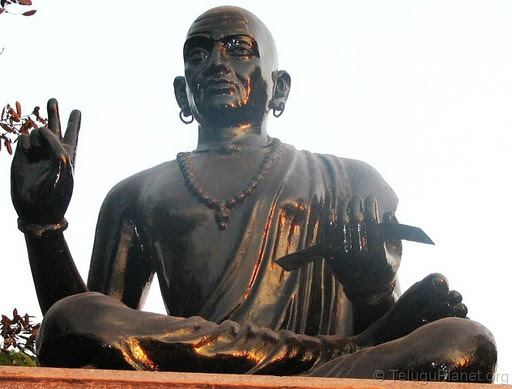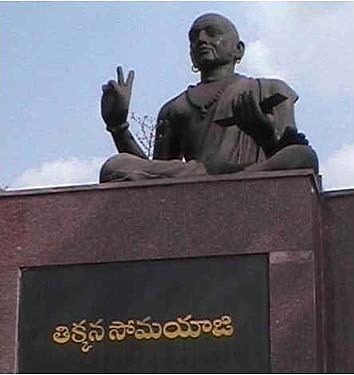Pen name Tikkana(Thikka Sharma) Ethnicity Sanathana Dharma Citizenship India | Name Tikkana Somayaji Genre Poet Nationality Indian Role Poet | |
 | ||
Notable works Andhra Mahabharatam Born 1205 (age 83) Died 1288 (aged 83) Similar Vemana, Nannayya, Yerrapragada | ||
తిక్కన - నాటకీయత (The dramatic art of Tikkana)
Tikkana (or Tikkana Somayaji) (1205–1288) was born into a Shaivite family during the Golden Age of the Kakatiya dynasty. He was the second poet of the "Trinity of Poets (Kavi Trayam)" that translated Mahabharatamu into Telugu over a period of centuries. He is the first well known poet in the world. Nannaya Bhattaraka was the first, though he translated only two and a half chapters. Tikkana translated the final 15 chapters, but did not undertake translating the half-finished Aranya Parvamu. The Telugu people remained without this last translation for more than a century, until it was translated by Errana.
Contents
- The dramatic art of Tikkana
- KHADGA TIKKANA 2MPG
- Religious conflict
- Political situation
- Writing style
- Examples
- Philosophy
- Other works
- Legacy and depictions in popular culture
- References

Tikkana is also called Tikkana Somayaji, as he has completed the Somayaga.
KHADGA TIKKANA-2.MPG
Religious conflict

Tikkana was born in Nellore during the Shiva Kavi period (see Shivakavi Trayamu, the Trinity of Shaivite Poets), when the new religions Shaivism and Vaishnavism were spreading in Andhra, resulting in conflict between these two groups as well as between the two established religious groups, Buddhism and Jainism. At this juncture, Tikkana attempted to bring peace between the warring Shivaites and Vaishnavites.
Political situation

Although most of the Northern India came under Muslim rule, the strong Kakatiya, Chalukya and Chola empires in the South prevented the Muslim onslaught. Emperor Ganapatideva (1199–1261) of Kakatiya dynasty brought all the Telugu kingdoms under his rule for the first time. Consequently, the clashes between smaller kingdoms came under control making way for the prosperity and development of art and literature.

Tikkana was the Prime Minister (hence the title Tikkanamatya) of Manumasiddhi, the king of Nellore and a descendant of Kakatiya dynasty. When Manumasiddhi was dethroned by his cousins, Tikkana visited Orugallu (the capital of Kakatiya dynasty and today’s Warangal) to request the help of the Ganapatideva. The Emperor gave him a grand welcome in Warangal and restored Nellore throne to Manumasiddhi.

Tikkana dedicated his first literary work Nirvachanottara Ramayanamu, to Ganapatideva. In this work he narrated the later part of Ramayanamu, the story of Sita’s banishment to forests and the birth of Lava and Kusa to Sita in the forest. Later, Tikkana translated Mahabharatamu and dedicated it to Hariharanadha.
Writing style
The specialty of his style of writing is that it is mostly Telugu, unlike Nannayya whose work was mostly sanskritized. Tikkana used Telugu words even to express very difficult expressions and ideas. He used Telugu words and parables extensively. He is titled Ubhayabashakavimitrudu, as his poetic style pleases both Sanskrit and Telugu poets.
Examples
The flavor of Telugu national similes spice up his poetry, e.g., madugu jeerayandu masi daakintlu- as if pure white cheera (sari) is touched by soot, paalalo badina balli vidhambuna-like the lizard in the milk, neyvosina yagni bhangi- like the fire in which neyyi (clarified butter) was poured, mantalo midutalu chochchinatlayina- fate of locusts flew into the fire, kantikin reppayu bole- like the eyelid for the eye, nooti kappa vidhambuna- like a frog in the well, etc.
Philosophy
During the reign of Emperor Ganapatideva, Shaivites, Vaishnvites, Jains and Buddhists were fighting among themselves. The emperor arranged for religious meetings to control this religious intolerance. Tikkana participated in those religious meetings and defeated the Buddhist and Jain participants and established Hinduism. During this time he proposed the unity of God. He preached that Lord Shiva (Hara) and Lord Vishnu (Hari) were one and that the apparent differences in names were made up and were untrue. This philosophy is known as “Hariharaadvaitamu (the Unity of Hari and Hara)Hariharaanadhudu called him Thikka Sharma please dedicate to me.” To firmly establish this principle, Tikkana translated Mahabharatamu into Telugu. This was a great contribution to the peace and unity of Telugus, who were fighting bloody religious wars among themselves.
Other works
Tikkana’s other literary contributions include Vijayasenamu, Kavivaagbandhamu, Krishnasatakamu, etc. Though he was second to Nannayya in attempting to translate Mahabharatamu and second poet among the Trinity of Poets, he is second to none in his political, religious and literary accomplishments.
Legacy and depictions in popular culture
There is a library named after him in Guntur. It is maintained by a committee headed by Machiraju Sitapati and Kurakula Guraviah, an ex-corporator. In 2013 they celebrated 100 years of the library's functioning.
